.
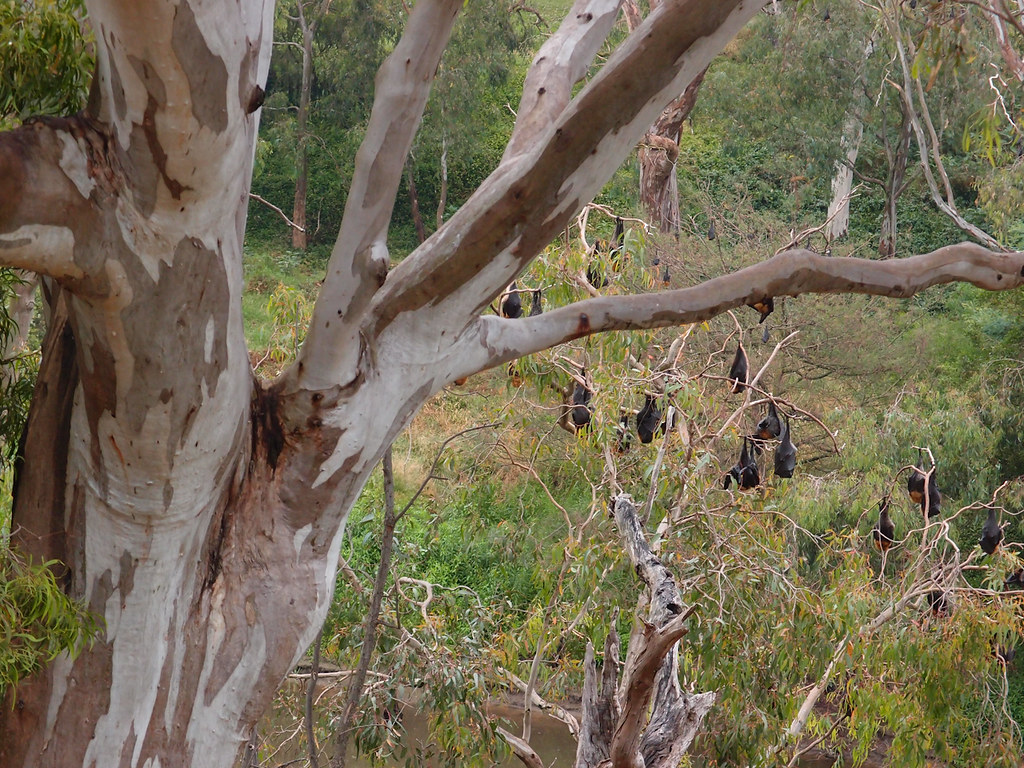
Roosting Grey-headed Flying Foxes (Pteropus poliocephalus), Yarra Bend Park, Melbourne: photo by Ruizhen, 14 December 2012
When I went into my room, at mid-morning,
Say ten o'clock . . .
My room, a crash-box over that great stone rattle
The Via de' Bardi. ...
When I went into my room at mid-morning
Why? . . . a bird_!
A bird
Flying round the room in insane circles.
In insane circles!
. . . A bat!
A disgusting bat
At mid-morning! . . .
Out! Go out!
Round and round and round
With a twitchy, nervous, intolerable flight,
And a neurasthenic lunge,
And an impure frenzy;
A bat, big as a swallow.
Out, out of my room!
The Venetian shutters I push wide
To the free, calm upper air;
Loop back the curtains. . . .
Now out, out from my room!
So to drive him out, flicking with my white handkerchief: Go!
But he will not.
Round and round and round
In an impure haste,
Fumbling, a beast in air,
And stumbling, lunging and touching the walls, the bell-wires
About my room!
Always refusing to go out into the air
Above that crash-gulf of the Via de' Bardi,
Yet blind with frenzy, with cluttered fear.
At last he swerved into the window bay,
But blew back, as if an incoming wind blew him in again.
A strong inrushing wind.
And round and round and round!
Blundering more insane, and leaping, in throbs, to clutch at a corner,
At a wire, at a bell-rope:
On and on, watched relentless by me, round and round in my room,
Round and round and dithering with tiredness and haste and increasing delirium
Flicker-splashing round my room.
I would not let him rest;
Not one instant cleave, cling like a blot with his breast to the wall
In an obscure corner.
Not an instant!
I flicked him on,
Trying to drive him through the window.
Again he swerved into the window bay
And I ran forward, to frighten him forth.
But he rose, and from a terror worse than me he flew past me
Back into my room, and round, round, round in my room
Clutch, cleave, stagger,
Dropping about the air
Getting tired.
Something seemed to blow him back from the window
Every time he swerved at it;
Back on a strange parabola, then round, round, dizzy in my room.
He could not go out,
I also realised. . . .
It was the light of day which he could not enter.
Any more than I could enter the white-hot door of a blast-furnace.
He could not plunge into the daylight that streamed at the window.
It was asking too much of his nature.
Worse even than the hideous terror of me with my hand-kerchief
Saying: Out, go out! . . .
Was the horror of white daylight in the window!
So I switched on the electric light, thinking: Now
The outside will seem brown. . . .
But no.
The outside did not seem brown.
And he did not mind the yellow electric light.
Silent!
He was having a silent rest.
But never!
Not in my room.
Round and round and round
Near the ceiling as if in a web,
Staggering;
Plunging, falling out of the web,
Broken in heaviness,
Lunging blindly,
Heavier;
And clutching, clutching for one second's pause,
Always, as if for one drop of rest,
One little drop.
And I!
Never, I say. . . .
Go out!
Flying slower,
Seeming to stumble, to fall in air.
Blind-weary.
Yet never able to pass the whiteness of light into freedom . . .
A bird would have dashed through, come what might.
Fall, sink, lurch, and round and round
Flicker, flicker-heavy;
Even wings heavy:
And cleave in a high corner for a second, like a clot, also a prayer.
But no.
Out, you beast.
Till he fell in a corner, palpitating, spent.
And there, a clot, he squatted and looked at me.
With sticking-out, bead-berry eyes, black,
And improper derisive ears,
And shut wings,
And brown, furry body.
Brown, nut-brown, fine fur!
But it might as well have been hair on a spider; thing
With long, black-paper ears.
So, a dilemma!
He squatted there like something unclean.
No, he must not squat, nor hang, obscene, in my room!
Yet nothing on earth will give him courage to pass the sweet fire of day.
What then?
Hit him and kill him and throw him away?
Nay,
I didn't create him.
Let the God that created him be responsible for his death . . .
Only, in the bright day, I will not have this clot in my room.
Let the God who is maker of bats watch with them in their unclean corners. . . .
I admit a God in every crevice.
But not bats in my room;
Nor the God of bats, while the sun shines.
So out, out you brute! . . .
And he lunged, flight-heavy, away from me, sideways, a sghembo!
And round and round and round my room, a clot with wings,
Impure even in weariness.
Wings dark skinny and flapping the air.
Lost their flicker.
Spent.
He fell again with a little thud
Near the curtain on the floor.
And there lay.
Ah death, death
You are no solution!
Bats must be bats.
Only life has a way out.
And the human soul is fated to wide-eyed responsibility
In life.
So I picked him up in a flannel jacket,
Well covered, lest he should bite me.
For I would have had to kill him if he'd bitten me, the
impure one. . . .
And he hardly stirred in my hand, muffled up.
Hastily, I shook him out of the window.
And away he went!
Fear craven in his tail.
Great haste, and straight, almost bird straight above the Via de' Bardi.
Above that crash-gulf of exploding whips,
Towards the Borgo San Jacopo.
And now, at evening, as he flickers over the river
Dipping with petty triumphant flight, and tittering over the
sun's departure,
I believe he chirps, pipistrello, seeing me here on this terrace writing:
There he sits, the long loud one!
But I am greater than he . . .
I escaped him. . . .
Florence
__
sghembo! (Italian): obliquely
pipistrello (Italian): bat
D. H. Lawrence (1885-1930): Man and Bat, from Birds, Beasts and Flowers: Poems (1923)
D. H. Lawrence (1885-1930): Man and Bat, from Birds, Beasts and Flowers: Poems (1923)

Grey-headed Flying Foxes (Pteropus poliocephalus), roosting at a daytime camp near Allora, Queensland: photo by Bruce Thomson, 23 September 2008

A small group of Black Flying Foxes (Pteropus alecto): photo by Justin A. Welbergen, 18 June 2003

Groups of Black Flying Foxes (Pteropus alecto) resting in a tree: photo by Justin A. Welbergen, 23 April 2003

Black Flying Fox (Pteropus alecto), seen on a walk around Florence Falls, Northern Territory, Australia: photo by Jon Clark (jonclark2000), 18 January 2013

Roosting Grey-headed Flying Foxes (Pteropus poliocephalus), New South Wales: photo by Justin A. Wellbergen, 13 August 2009
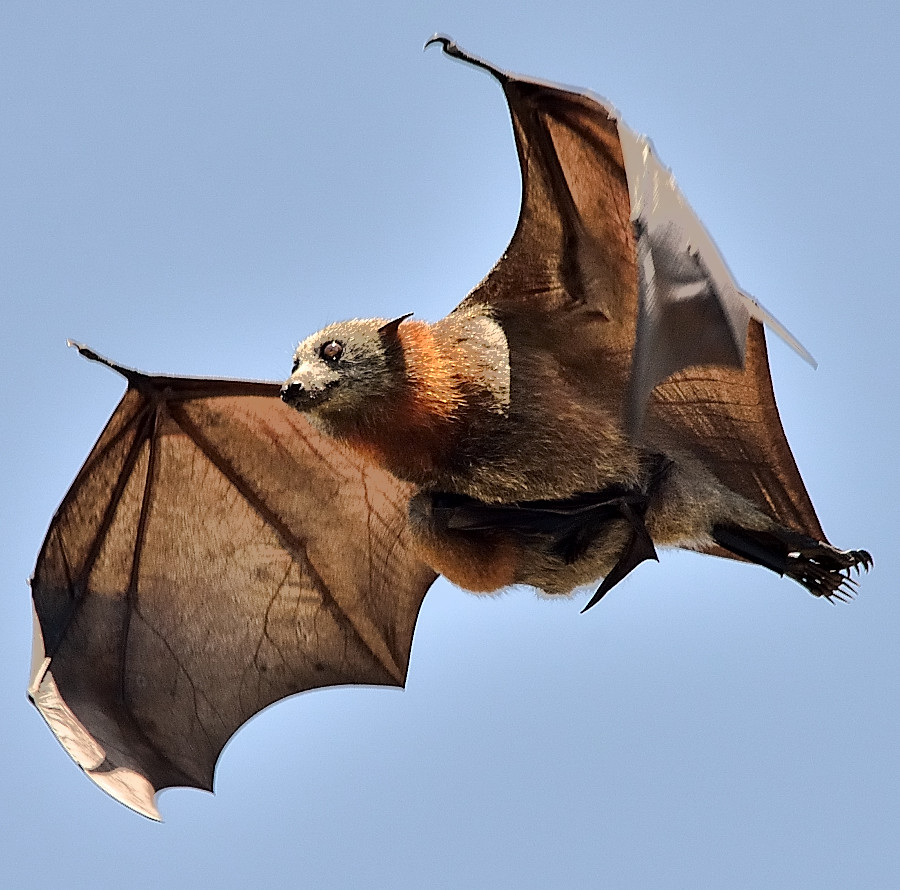
Baby bat burden back again. Grey headed Flying Fox (Pteropus poliocephalus), carrying pup, North Parramatta, Sydney. I appeal to all to recognise that dangerous climate change is already here. On 18 January 2013 Sydney experienced its highest temperature in recorded history -- 46'C (115'F). These bats (especially the babies) are at extreme risk of dying from heat stress at temperatures over 43'C. 500 bats (90% were pups) died on this day in one colony alone (Parramatta). These "babies" are getting so big it is hard for mum to stay aloft! Bat babies get it good (but not in this heat!) -- suckling mumma's milk while getting carried everywhere: photo by Peter (snowed under without any snow)(pppumpkine), 18 December 2012

Black Flying Fox (Pteropus alecto), Parramatta, Sydney. I appeal to all to recognise that dangerous climate change is already here. On 18 January 2013 Sydney experienced its highest temperature in recorded history -- 46'C (115'F). These bats (especially the babies) are at extreme risk of dying from heat stress at temperatures over 43'C. 500 bats (90% were pups) died on this day in one colony alone (Parramatta): photo by Peter (snowed under without any snow)(pppumpkine), 18 January 2013
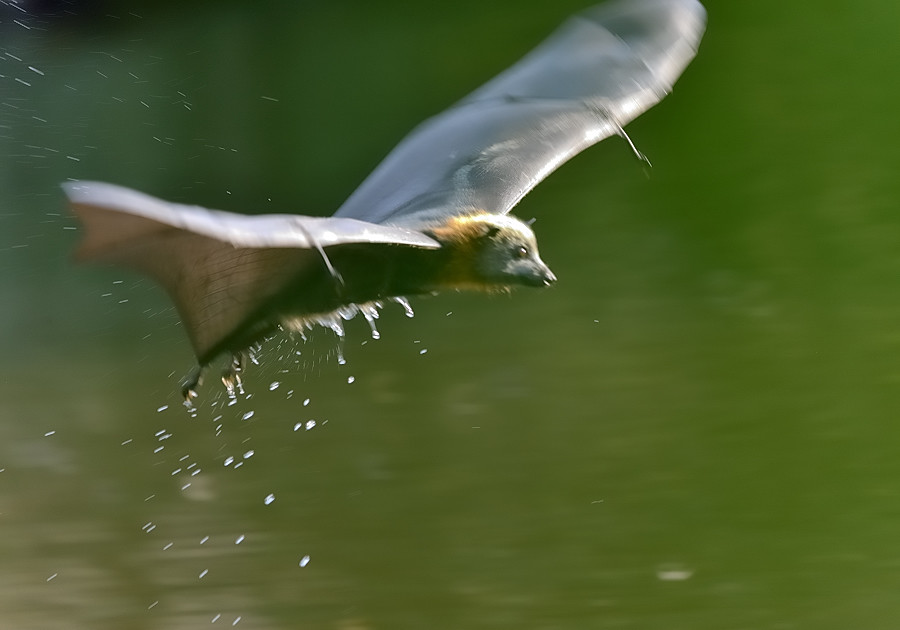
Thirsty bat on a very hot day, Sydney. Grey headed Flying Fox (Pteropus poliocephalus), Parramatta. Get home quickly without spilling too much! This is the way that bats drink -- dunk their hairy chest in the river, fly back to their roost, enjoy a cool hairy drink by licking their fur. She really needed this drink after a 40'C day, and there was hotter weather to come: photo by Peter (snowed under without any snow)(pppumpkine), 8 January 2013
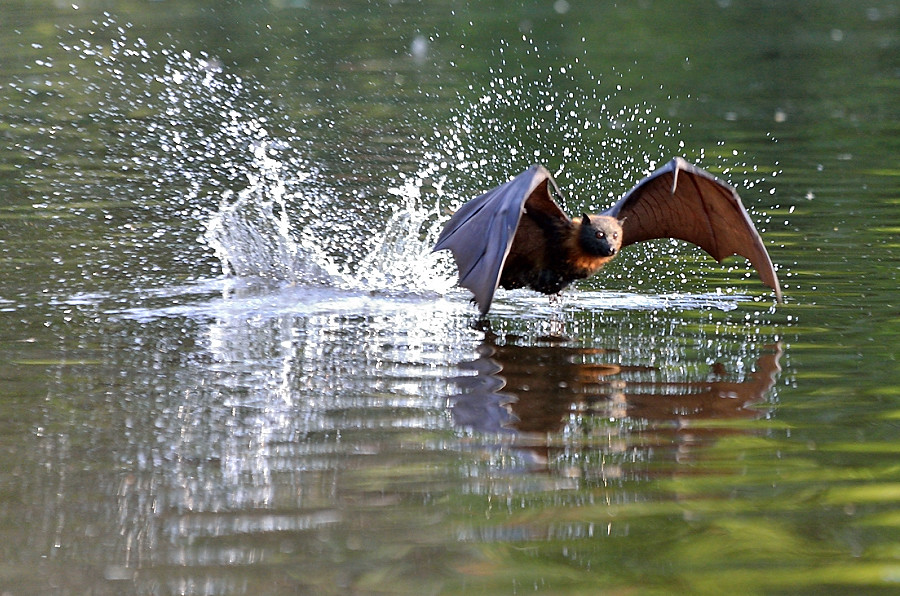
Ka-sploosh! Dunking the chest for a cool drink back at the branch. North Paramatta, Sydney: photo by Peter (snowed under without any snow)(pppumpkine), 8 January 2013

Adult male Grey-headed Flying Fox (Pteropus poliocephalus), suffering from heat stress, Emu Plains, New South Wales: photo by Justin A Welbergen, 18 January 2013

Cluster of juvenile Grey-headed Flying Foxes (Pteropus poliocephalus) dying of heat stress, Emu Plains, New South Wales: photo by Justin A. Welbergen, 18 January 2013
Flying foxes will commonly use
wing-fanning to cool themselves. As temperatures rise further they will
seek shade by coming down onto the trunk of the tree under the canopy.
Thermal imaging has shown the trunk to be significantly cooler than the
surrounding air. When these strategies are no longer adequate, panting
and licking can be effective but the loss of body water is significant.
At this stage they face death. There have been several mass deaths in
the last decade where up to 8000 animals have died in one day.
Climate change and the impacts of extreme events on Australia's Wet Tropics Biodiversity:
Dr Justin Welbergen, Centre for Tropical Biodiversity and Climate
Change, School of Marine and Tropical Biology, James Cook University
(2013)
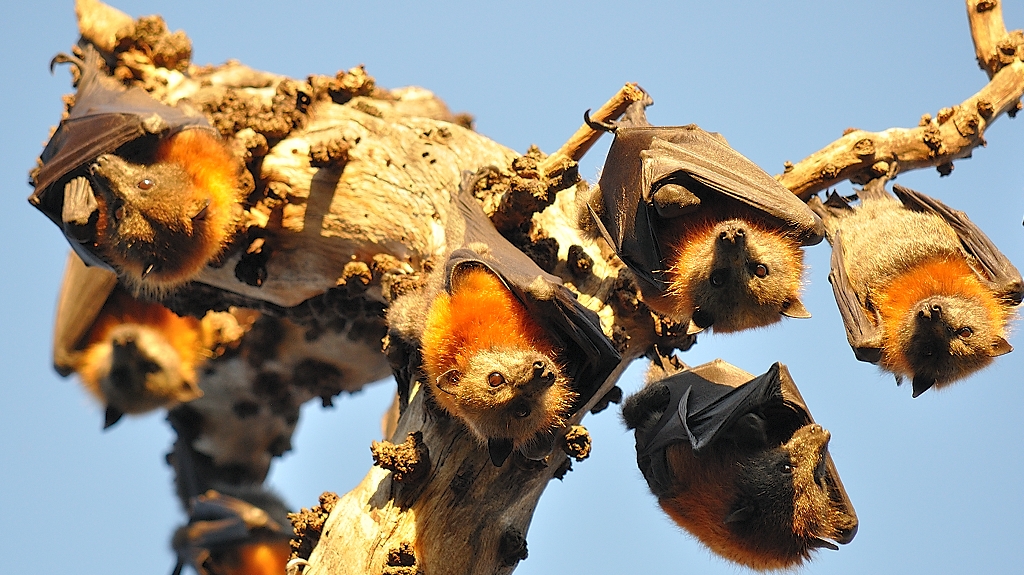
The nursery. Grey-headed Flying Foxes (Pteropus poliocephalus), North Parramatta, Sydney: photo by: photo by Peter (snowed under without any snow)(pppumpkine), 18 January 2011
Over
the past 100 years, the global average temperature has increased by
approximately 0.74±0.18°C and is projected
to continue to rise at a rapid rate. Changes in
climate are significant for natural systems as they can affect
population abundance, shifts in species range
distributions and the number of species invasions
and extinctions. Recently, extreme weather events have gained in
importance relative to gradual climatic trends as mechanistic drivers of
broad ecological responses to climatic change.
Temperature extremes that exceed physiological limits can cause
widespread mortality, as evidenced by the 2003 heat wave
in Europe that resulted in more than 15 000 human
fatalities in France alone.
However, very little is known about the kinds of effects that
temperature extremes have on natural systems. This is a matter
of increasing concern now that current climate
models predict a dramatic increase in the frequency, intensity and
duration
of temperature extremes, through the combined
effects of a shift towards warmer and more variable temperatures.
In this study, we examined the effects of temperature extremes on the behaviour and demography of Australian flying-foxes
(Pteropus spp.). The grey-headed flying-fox (Pteropus poliocephalus) and the black flying-fox (Pteropus alecto) are among the largest species of fruit bats. Pteropus poliocephalus
is endemic to coastal southeastern Australia and it extends into higher
latitudes than any other pteropodid. In northern New South Wales
and southern Queensland, P. poliocephalus shares colonies with P. alecto . The range of P. alecto
extends from Papua New Guinea and Indonesia into the forested areas of
northern NSW along the east coast of Australia. At
night, both pteropodids forage for nectar, pollen
and fruit, and during the day they roost in large aggregations
(colonies/roosts/camps)
that may contain thousands of individuals. They
provide important ecosystem services, including pollination of wild and
cultivated crops and seed dispersal. However, they are exposed to
threatening anthropogenic factors, the most serious of which are ongoing
loss of foraging and roosting habitat, direct killing of animals in
orchards and harassment and destruction of roosts. The species are
listed as Vulnerable on the NSW Threatened Species Conservation Act 1995
(P. alecto and P. poliocephalus), and the Commonwealth Environment Protection and Biodiversity Conservation Act 1999 (P. poliocephalus).
Because flying-foxes roost among the exposed branches of canopy trees,
they are particularly sensitive to the effects of
extreme temperatures, and therefore are convenient
indicators for assessing the impact of temperature extremes on the
natural
environment.
On 12 January 2002, weather stations in
coastal eastern Australia recorded maximum temperatures that were up to
16.5°C higher
than the 30-year average mean daily maximum. This
single extreme temperature event was associated with the death of
thousands
of flying-foxes, providing a unique opportunity to
assess directly the effects of a temperature extreme on large
terrestrial
vertebrates.
.
Our main study site (Dallis Park) is occupied by a mixed-species colony and is located near the
southern end of the zone of range overlap between P. poliocephalus and P. alecto. The colony has been the subject of an intensive ecological study since 2000.
On 12 January 2002, we documented individual behaviour,
thermoregulatory responses and changes in roosting patterns, commencing
at 06.00 hours until approximately 15.00 hours. At
approximately 11.30 hours, the behaviour of animals started to depart
notably
from normal. Observations were supplemented by
time-coded photographics.
On January 13 and 14, we systematically searched the Dallis Park colony and adjacent areas for corpses, and classified a total
of 1361 bodies by species (i.e. P. alecto versus P. poliocephalus)...
.
.
As the temperatures were rising in the Dallis Park colony on 12 January 2002, both P. alecto and P. poliocephalus
showed the following sequence of behaviours: (i) wing-fanning
(start: approx. 10.00 hours), (ii) shade-seeking
(start: approx. 11.15 hours), (iii) panting (start: approx. 13.15 hours)
and (iv) saliva-spreading (start: approx. 13.45
hours). Later, individuals began falling from the trees (start: approx.
13.53
hours). Fallen individuals became increasingly
lethargic and died within 10–20 min.
The behavioural sequence displayed by both species closely resembled that reported elsewhere and seems adaptive for maintaining
body temperature (Tb) against increasing ambient temperature (Ta). Wing-fanning facilitates thermoregulation by forced convection and shade-seeking lowers Tb by reducing direct radiation absorption from sunlight. When the Ta exceeds Tb, wing-fanning and shade-seeking are no longer adequate for heat dispersal, but panting and saliva-spreading can still reduce
Tb by increasing
evapotranspiration. The loss of body water will be significant, however,
and animals should deploy this strategy only when Tb has risen close to lethal limits.
Animals started dying approximately 1
hour before the temperature at the nearest weather station reached an
all time high
of 42.9°C, which was 3.1 s.d. higher than the
average monthly summer maximum (35.3°C), and a 13.8°C departure from
normal.
The same weather station recorded 40.2, 40.7, 40.9
and 41.2°C in summer 2002, 2001, 2004 and 1994, respectively, without
any
evidence of mortality.
The
minimum number of bats that died in the colony on 12 January 2002 was
1453 (approx. 5–6% of the bats present). Mortality was significantly
higher among P. alecto than P. poliocephalus (10–13% versus less than 1%...). This suggests that P. alecto has lower species-specific physiological limits for coping with high temperatures than P. poliocephalus.
from Climate change and the effects of temperature extremes on Australian flying-foxes: Justin A. Welbergen et al.: Proceedings of the Royal Society (Biological Sciences), vol. 75 no. 1633, 22 February 2008
Temperature extremes have caused the death of tens of thousands of Australian flying-foxes in the last decade alone causing some of the most dramatic mass die-offs ever to have been recorded in mammals. Such extremes selectively affect the effective breeding population and recruitment of the species, which further exacerbates their impact. Since temperature extremes are expected to increase in the future, mass die-offs will become more frequent and widespread, and will occur at lower latitudes than previously. This will undoubtedly increase the threat to the survival of the species in addition to the anthropogenic factors that have already been identified.
from The
grey-headed flying-fox, Pteropus poliocephalus: Justin A. Welbergen, Behavioural Ecology Group, Department of Biology, School of Biological Sciences, University of Cambridge
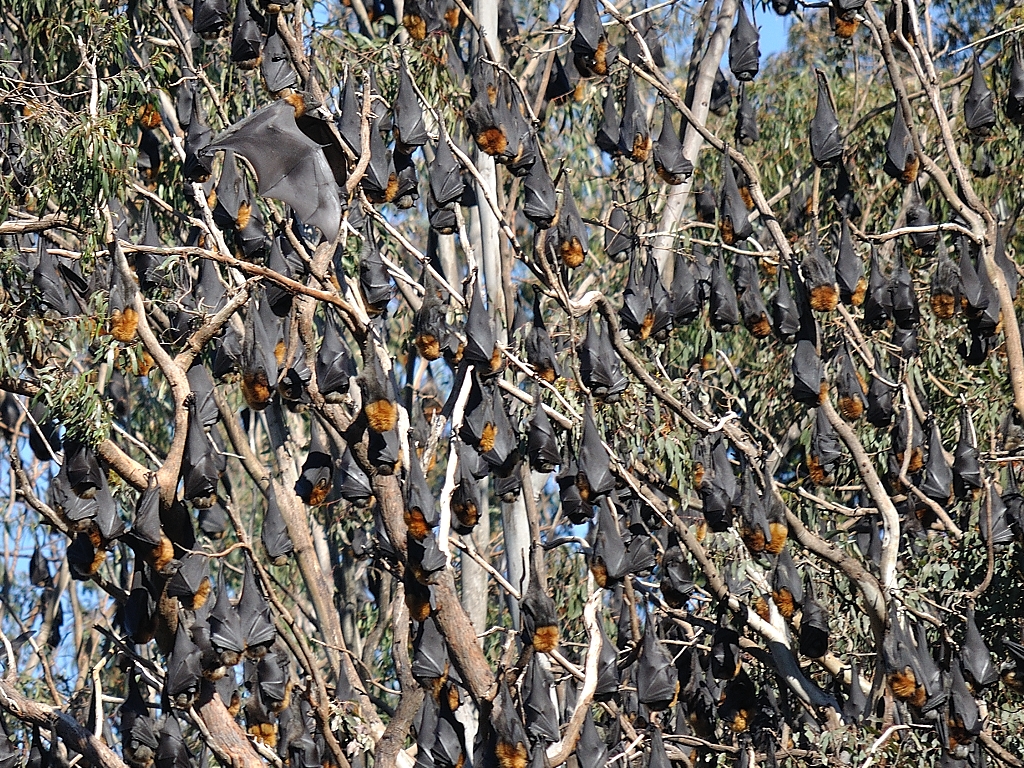
Colony of Grey-headed Flying Foxes (Pteropus poliocephalus), roosting, North Parramatta, Sydney: photo by: photo by Peter (snowed under without any snow)(pppumpkine), 18 January 2011
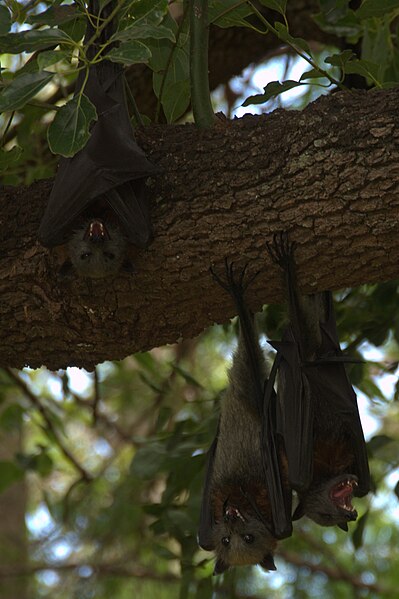
"No Me, No Tree!" The Grey-headed Flying Fox
ReplyDeleteRegarding the Lawrence text only, I read through this in absolutely breathless excitement. When I first saw it appear, I thought I'd get to it later because of its length. But I dove in and followed it down and out the window. Bats are absolutely extraordinary. The other week when we were driving in Massachusetts between Gloucester and Rockport and saw the enormous, horrifying windmills (real War of the Worlds items) that are so destructive to bats and birds, I became deeply angry and depressed. I first saw and heard bats flying around the eaves of a barn/theater at summer camp. I'll never forget it and I was terrified. But it was, I realize now, a kind of received and postured terror. I love them now and I love Lawrence's descriptions. The first photo below the poem is amazing and makes me think a little of the Bela Lugosi (in Dracula persona) audio appearance I heard yesterday on an Abbott & Costello radio show on Sirius Radio Classics. Curtis
ReplyDeleteThanks for the bats.
ReplyDeleteH.
Lawrence can be plain and frank about his disgust and still conjure a kind of reverence. The pacing of the poem is wonderful.
ReplyDeleteI can believe in a god of bats. Something of a struggle to imagine a god of New South Wales politicians.
The Grey-headed Flying Fox is a "keystone" species, supporting the rainforest ecology by scattering seed from the fruit it gathers; to keep light for flight it digests only the liquids, scattering the bulk upon the wind by means of virtually instant elimination.
ReplyDeleteThe species thrived in continuous specific colonies on the East Coast region of Australia for longer than anyone knows, but now, suddenly, the climatic "tipping point" imperils the species, bringing mass die-offs of the young.
The uncanny visceral response bats evoke in our species perhaps has something to do with the neither-nor body definition, almost mermaid-like; the vulnerability of the species, when down out of the trees, is immediate and constant.
Bats are quite intelligent, with brains five or six times the size (relative to body mass) of those of dogs; and they have incredibly complex and sustaining systems of social organisation.
To reflect even for a moment upon the evolutionary development that produced these astonishing creatures is to pause in wonder before the world as it was before we came along to mess it up.
The in actu quality of the poem, Lawrence struggling with the bat, with his own aversion, and with his urgent impulse to note it all down, is quite remarkable.
He also composed a more "writerly", distanced companion poem. I went back and forth trying to decide which one to post. As the poems are quite different, each wonderful in its way, and, I think, equally good, I decided in the end to post them both, so that readers may compare for themselves.
D. H. Lawrence: Bat